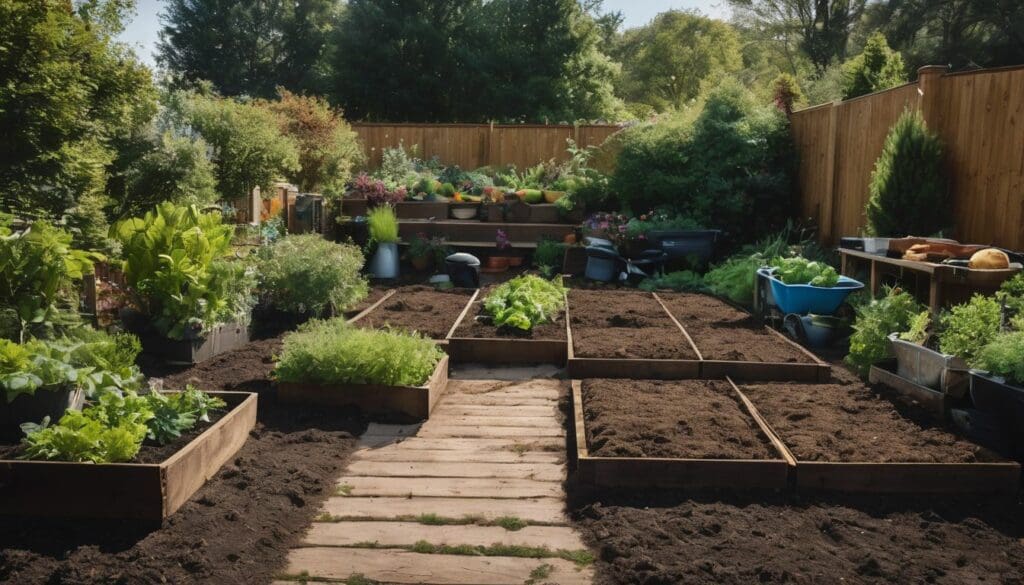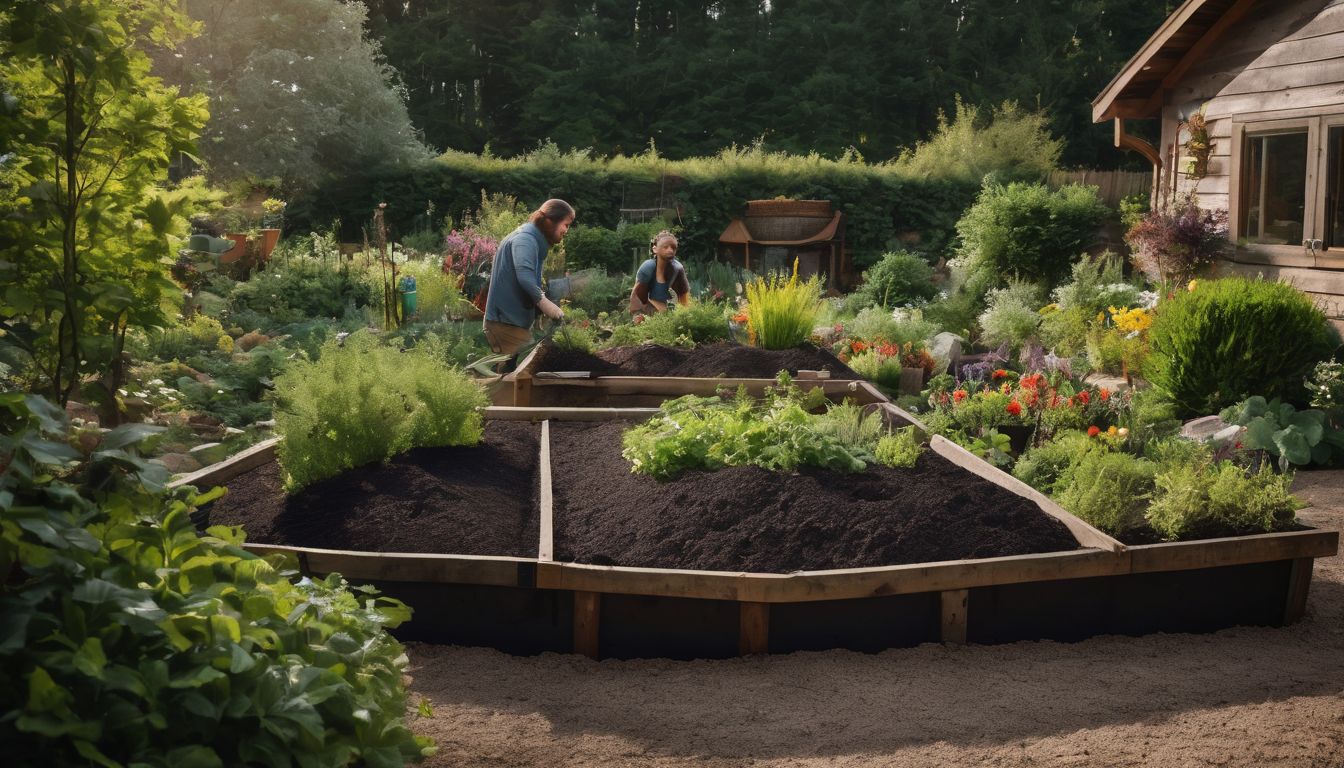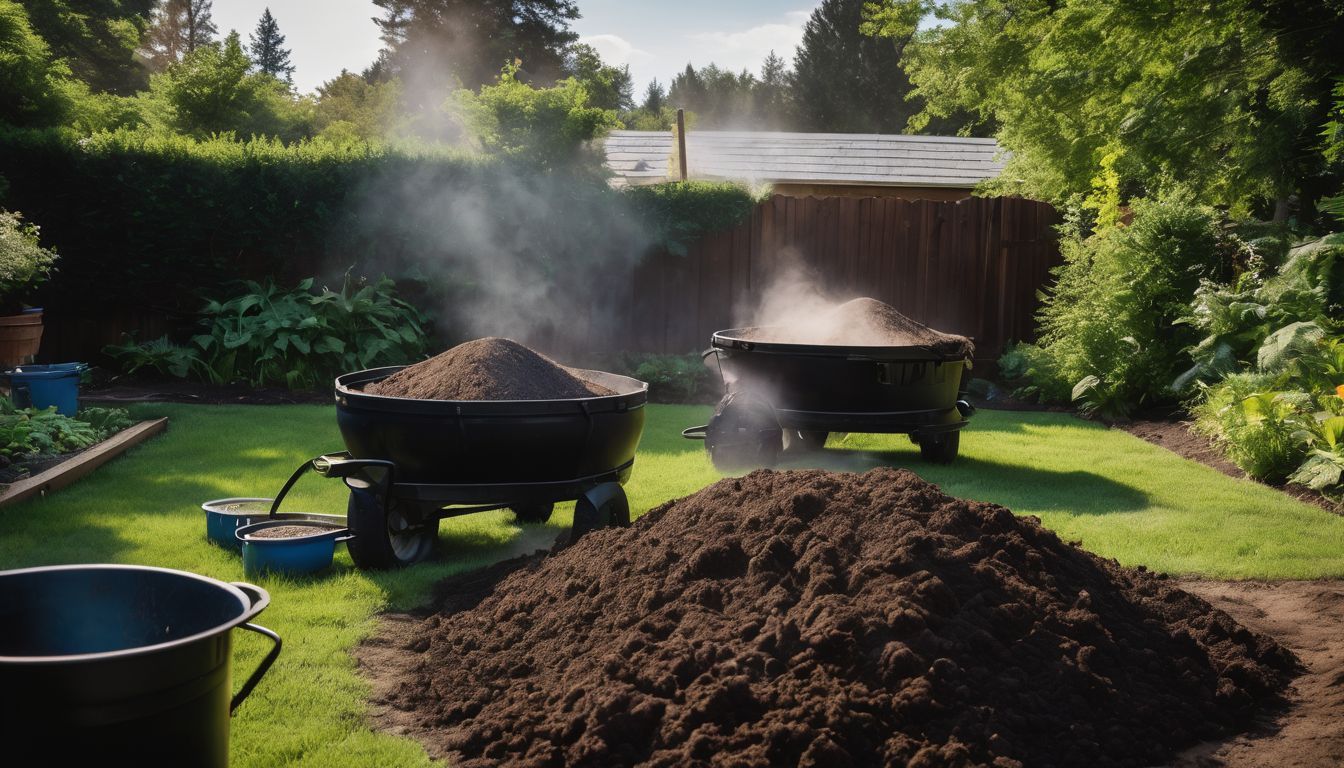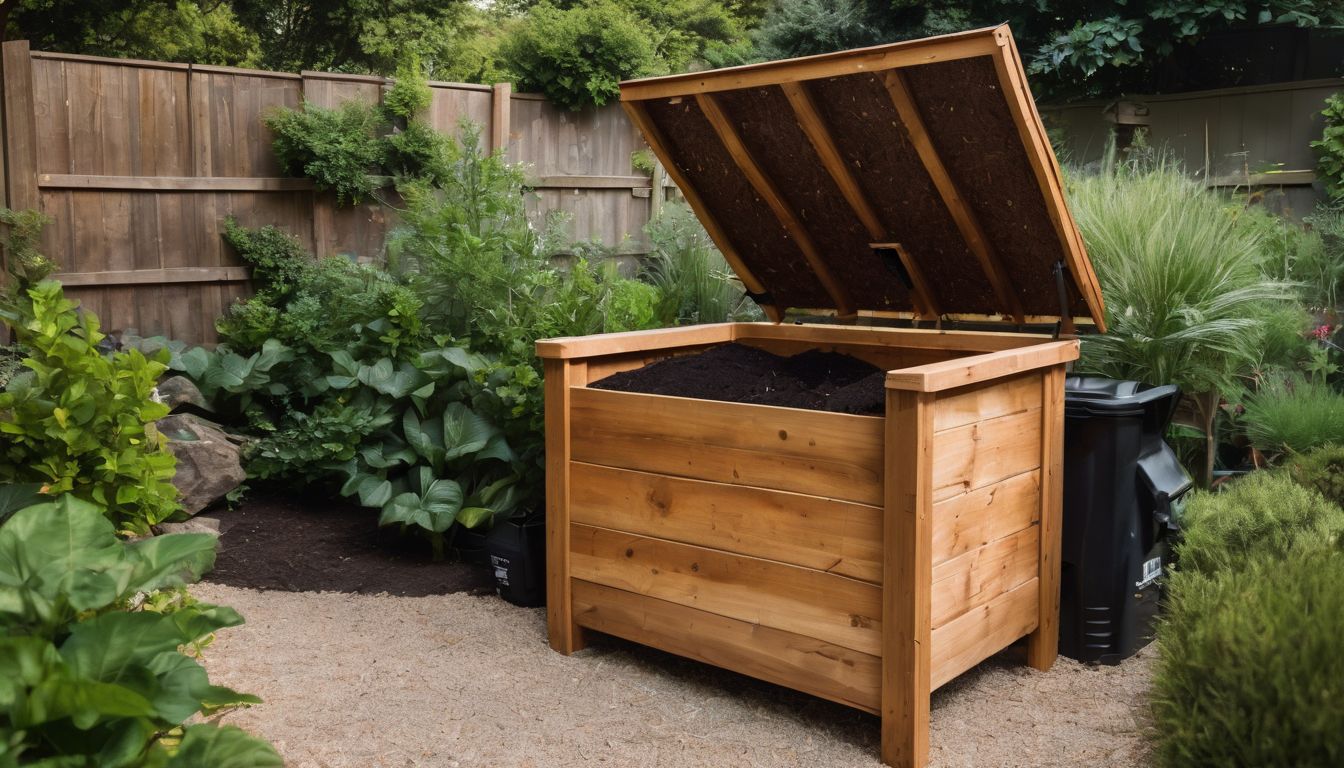Tired of seeing your food scraps go to waste? Surprisingly, a third of the food produced globally is never eaten. Our guide will turn that waste into garden gold, showing you how simple it can be to create rich soil from leftovers.
Discover how composting works, and let’s dig in!
Key Takeaways
- Composting turns organic waste like kitchen scraps and yard trimmings into nutrient – rich soil, reducing landfill waste and methane emissions.
- Microorganisms such as bacteria and fungi are vital in breaking down compost materials; their activity helps to create a stable mix called humus, which enriches garden soil.
- There are various methods of home composting including backyard composting, community schemes, on-site systems, and worm composting (vermicomposting), each suitable for different levels of involvement and space availability.
- The right balance of ‘green’ nitrogen-rich materials (e.g., food scraps) with ‘brown’ carbon-rich materials (e.g., dry leaves) is essential for successful decomposition in the composting process.
- Finished compost can be used as a natural fertiliser to improve soil health while outsourcing remains an option for those who cannot manage their own compost at home.
What is Composting?
Composting is the natural process of recycling organic matter, such as kitchen scraps and yard waste, into a rich soil amendment. Microorganisms play a crucial role in breaking down the materials to create nutrient-rich compost.
Definition and process
Composting transforms organic waste into a nutrient-rich fertiliser, enhancing soil health and supporting plant growth. In this natural recycling process, microorganisms break down biodegradable materials in the presence of oxygen.
You start by mixing green waste like vegetable scraps with brown materials such as leaves and twigs. This blend then undergoes aerobic decomposition, where bacteria and fungi play vital roles.
They consume the waste, producing heat that accelerates decomposition.
The composting journey involves carefully controlling conditions to maintain ideal moisture and air levels for the organisms at work. Through thermal phases, the pile’s temperature rises and falls, each stage further breaking down complex organic matter into simpler compounds.
Over time, this intricate dance of natural forces results in humus formation—a stable mix loaded with nutrients ready to enrich your garden’s soil without leaving behind harmful residues or chemicals.
Role of microorganisms
Microorganisms play a crucial role in the composting process. Bacteria, fungi, and other tiny organisms break down organic matter into nutrient-rich soil. They thrive in aerobic conditions where oxygen is present, aiding in the decomposition of plant material, such as leaves and food scraps.
These microorganisms release enzymes that help to break down complex compounds into simpler forms, facilitating the formation of humus – a dark organic substance that enhances soil fertility.
The activity of microorganisms also generates heat within the compost pile, promoting ideal conditions for decomposition. Their role in converting carbon from organic matter into stable forms helps reduce methane emissions during waste decay.
Benefits of Composting
Composting offers numerous environmental benefits, including the reduction of waste and methane emissions, improvement of soil health, water conservation, and the reduction of personal food waste.
These benefits make composting an essential practice for environmentally conscious individuals.
Reduces waste and methane emissions
Composting reduces waste by diverting organic materials from landfills where they emit methane, a potent greenhouse gas. By breaking down organic matter aerobically in controlled conditions, composting prevents the release of methane while producing valuable soil-enriching material.
This natural process not only helps to manage organic waste but also aids in reducing our carbon footprint and mitigating climate change.
In addition to lessening environmental impact, composting plays a crucial role in nutrient cycling by returning essential nutrients like nitrogen and phosphorus back into the soil, promoting healthier plant growth and enhancing overall soil quality.
Improves soil health
Composting improves soil health by enriching it with valuable nutrients and promoting beneficial microbial activity. The organic matter in compost helps to improve soil structure, water retention, and aeration, which are essential for healthy plant growth.
Furthermore, the use of compost reduces the need for chemical fertilisers, preventing potential harm to the environment.
Not only does composting provide an environmentally friendly way to manage waste, but it also supports sustainable agricultural practices and contributes to overall ecosystem health.
By incorporating compost into gardening and farming activities, individuals can actively participate in conserving natural resources while promoting better soil quality for future generations.
Worm composting (vermicomposting), in particular, offers a practical solution for enhancing soil fertility on a smaller scale.
Conserves water
Composting conserves water by improving soil structure and its ability to retain moisture. When compost is added to soil, it acts like a sponge, reducing the need for frequent watering.
This can significantly benefit areas facing drought conditions or where water conservation is crucial. Additionally, compost helps prevent erosion by keeping the soil in place during heavy rain, further safeguarding water resources.
The process of composting also reduces the demand for synthetic fertilisers that can contribute to water pollution. Through decomposing organic matter, nutrients are released slowly into the soil, promoting healthier plant growth without adding unnecessary chemicals.
Reduces personal food waste
Composting reduces personal food waste. Food scraps, leftovers, and peels can be composted instead of ending up in landfills. When organic waste is composted, it breaks down naturally with the help of microorganisms and turns into nutrient-rich soil amendment.
By composting at home or through community programs, individuals can significantly reduce the amount of food waste they contribute to the environment.
Moreover, composting helps divert organic materials from landfills where they would otherwise generate methane gas—a harmful greenhouse gas that contributes to climate change. Instead, these materials are returned to the soil as valuable nutrients, enriching it and supporting healthier plant growth.
Types of Home Composting
Backyard composting, community composting, on-site composting, and worm composting (vermicomposting) are different approaches to composting. Read on to learn more about each method and find the one that suits you best!
Backyard composting
Backyard composting allows you to recycle organic waste such as kitchen scraps and yard trimmings, turning them into nutrient-rich soil conditioner for your garden. Choose a dry, shady spot near a water source to set up your compost bin or pile.
Layer green materials like fruit peels and grass clippings with brown materials such as leaves and paper to provide the right balance of nitrogen and carbon for decomposition.
Keep the compost moist but not soggy, turning it regularly to aerate and speed up the process. Avoid meat, dairy products, and diseased plants in your backyard compost as they attract pests or introduce pathogens that could harm your garden.
Community composting
Community composting is a collaborative effort to recycle organic waste within a neighbourhood or community. In this process, individuals and families contribute their food scraps and yard waste to a communal composting site.
Microorganisms break down the materials into nutrient-rich soil amendments, which are then used to enrich local gardens and green spaces. Community composting not only reduces the amount of waste sent to landfills but also fosters a sense of shared responsibility for environmental stewardship.
Participating in community composting provides an opportunity for people from diverse backgrounds to come together with a common goal of promoting sustainability. It encourages cooperation, education, and engagement with the natural processes that sustain life on Earth.
On-site composting
Transitioning from community composting to on-site composting, this method allows individuals to manage their organic waste directly at home or within their property. On-site composting involves creating a small-scale system for turning kitchen scraps and yard waste into valuable soil amendment.
It offers the convenience of managing waste on a daily basis while contributing to environmental conservation efforts through nutrient return to the soil in controlled conditions. Additionally, it helps reduce methane emissions associated with transporting organic waste to landfills and supports sustainable gardening practices by enriching the soil with essential nutrients and beneficial microorganisms that facilitate a healthy ecosystem.
The process is relatively simple, requiring minimal space and maintenance, making it an ideal option for environmentally conscious individuals looking to actively reduce personal food waste while contributing positively towards enhancing soil health within their immediate surroundings.
Worm composting (vermicomposting)
Worm composting, also known as vermicomposting, utilises worms to decompose organic waste. The process involves placing red wigglers or earthworms in a container with food scraps and allowing them to break down the material into nutrient-rich compost.
These composting worms consume the organic matter and convert it into a beneficial soil amendment that can be used to enrich garden soil and nourish plants. Vermicomposting is an eco-friendly way to manage kitchen waste, reduce landfill contribution, and create a sustainable source of natural fertiliser for gardens.
Utilising worms for composting offers an efficient method for environmentally conscious individuals interested in reducing their carbon footprint, managing household waste sustainably, and contributing to soil enrichment.
Worm composting aligns seamlessly with conservation efforts by minimising methane emissions from landfills and supporting nutrient return to the soil in a controlled environment.
How to Compost
To compost effectively, it’s important to choose the right site and structure, ensure proper aeration and moisture maintenance, and have a good balance of compost ingredients. Understanding what can and cannot be composted is also essential for successful composting.
Choosing the right site and structure
To ensure a successful composting process, it is essential to choose the right site and structure. Consider the following factors when selecting a location and setup for your compost:
- Locate the compost pile or bin in a well – drained area with good air circulation.
- Choose a spot away from direct sunlight to prevent excessive drying.
- Ensure the location is easily accessible for adding materials and turning the compost.
- Select a structure that suits your needs, such as a homemade wooden bin or commercially available compost tumbler.
- Consider the size of the structure based on the amount of organic waste you plan to compost.
- Opt for a design that allows for proper aeration and moisture management within the compost pile or bin.
- Evaluate whether an enclosed or open – air system is more suitable based on local climate conditions and available space.
Compost ingredients
Compost ingredients play a crucial role in the composting process. They include a mix of “green” and “brown” materials. Green materials are nitrogen-rich, such as fruit and vegetable scraps, grass clippings, and coffee grounds. Brown materials are carbon-rich, like dry leaves, straw, and shredded paper. These materials provide the necessary balance for effective decomposition. The right mix of these ingredients ensures proper aeration and moisture levels needed for microorganisms to break down the organic matter.
- Green materials: Fruit and vegetable scraps, grass clippings, coffee grounds
- Brown materials: Dry leaves, straw, shredded paper
Aeration and moisture maintenance
After selecting the right ingredients for your compost, it’s crucial to focus on aeration and moisture maintenance to ensure the optimal conditions for decomposition. Here are the key steps to follow:
- Turn or mix the compost regularly to introduce air into the pile, promoting aerobic decomposition.
- Keep the compost moist like a wrung – out sponge to facilitate microbial activity and breakdown of materials.
- Use a cover or tarpaulin to protect the compost from excessive rain, which can lead to waterlogging.
- Monitor moisture levels regularly and add dry materials if the compost becomes too wet or waterlogged.
- Consider using a compost thermometer to check internal temperatures, optimising decomposition.
What can and cannot be composted
Certain items can be composted, while others are not suitable for the composting process. Here is a list of what you can and cannot compost:
- You can compost fruit and vegetable scraps, coffee grounds, tea leaves, and eggshells.
- You can compost yard waste such as grass clippings, leaves, and small branches.
- You can compost paper products like shredded newspaper, cardboard, and paper towels.
- You can compost plant – based materials such as straw, wood chips, and sawdust.
- Do not compost meat or fish scraps, dairy products, greasy foods, or bones.
- Do not compost pet waste or cat litter.
- Do not compost diseased plants or weeds that have gone to seed.
Using Compost and Outsourcing
Once your compost is ready, you can use it as a natural fertiliser for your garden and plants. If you don’t have the space or time to compost at home, consider outsourcing your food waste to a community or commercial composting facility.
How to use finished compost
- Spread a layer of compost around the base of plants, trees, and shrubs to improve soil structure and retain moisture.
- Mix compost into potting soil or garden beds to enhance nutrient levels and support healthy root growth.
- Use compost as mulch to suppress weed growth, regulate soil temperature, and reduce erosion.
- Create a nutrient – rich tea by steeping compost in water and use it as a natural fertiliser for potted plants or garden beds.
- Outsourcing Composting
Outsourcing composting
Once you have finished compost ready to use, you may consider outsourcing the composting process. Outsourcing composting services can be an efficient way to manage larger quantities of organic waste without requiring additional space and resources at your own property.
This option allows you to contribute to environmental sustainability by diverting more waste from landfills and supporting local businesses that offer professional composting solutions, ensuring proper handling and processing of organic materials.
Additionally, purchasing finished compost from reputable suppliers provides a convenient source of nutrient-rich soil amendment for your garden or landscaping needs while promoting circular economy principles within your community.
Safety precautions
Before starting the composting process, it is essential to take some safety precautions. Always wear gloves and a mask when handling compost materials to protect your skin and respiratory system from potential irritants or allergens.
Additionally, regularly turning the compost pile with a pitchfork or shovel will help ensure proper aeration and reduce the risk of harmful bacteria growth. Keep children and pets away from the composting area to avoid any accidental ingestion of compost materials.
As an extra measure, always wash your hands thoroughly after handling compost materials to prevent the spread of bacteria or pathogens. It’s also important to monitor the internal temperature of the compost pile using a thermometer to ensure that it reaches adequate levels for killing weed seeds and pathogens effectively.
Conclusion
Understanding the Composting Process
In conclusion, understanding the composting process allows us to contribute positively to our environment. Composting is a simple yet effective way to reduce waste, enrich soil, and lessen methane emissions.
By actively participating in composting at home or within communities, we can play an important role in sustainability efforts. Those who grasp the process of composting are better equipped to make informed choices that benefit both themselves and the environment.
FAQs
1. What exactly is the composting process?
The composting process is an aerobic method where microorganisms break down organic materials, resulting in nutrient-rich soil that helps plants grow.
2. Why are microorganisms important in composting?
Microorganisms play a crucial role in decomposing organic matter, speeding up the transformation into compost and returning valuable nutrients to the soil.
3. Can I control how fast my waste turns into compost?
Yes, you can influence the speed of decomposition by managing controlled conditions like moisture and temperature to create an ideal environment for composting.
4. Are there environmental benefits to making compost?
Absolutely! Composting reduces landfill waste and enriches soil without chemical fertilisers, contributing positively to environmental health.





